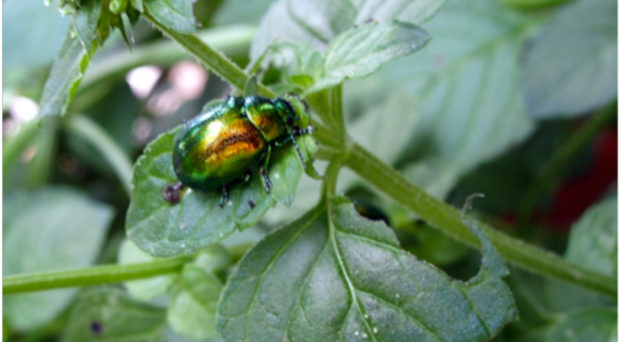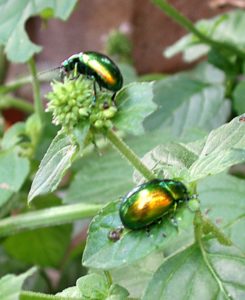
Plant-insect interaction and co-adaptation: a question of chemical cross-talk
In the long course of evolution, plants have evolved a wide range of defense mechanisms against insect herbivores, which can be distinguished into two categories: constitutive defenses and inducible defenses. The former ones are physical and chemical barriers existing before insect attack; the latter ones are direct and indirect defenses that are triggered by the insect attack.
In particular, direct defenses are plant traits able to directly interfere with attacking insects, whereas indirect defenses comprise plant traits that do not affect the susceptibility of host plants by themselves, but can serve as attractants to natural enemies of attacking insects. The response of insects to plant defenses includes the selective choice of different feeding sites, the alteration of the feeding rate or the induction of detoxifying enzymes.
In the long course of evolution, plants have evolved a wide range of defense mechanisms against insect herbivores, which can be distinguished into two categories: constitutive defenses and inducible defenses.
Plants that accumulate specialized metabolites like the aromatic plant Mentha aquatica (the watermint) deter herbivory with a direct defense mechanism, by producing terpenoids in glandular trichomes, which are specialized secretory tissues. Despite the toxic content of such secretory structures, specialized herbivores not only feed on plants bearing these structures, but have also evolved the ability to recognize and be attracted by specific compounds. Therefore, interactions between plants and insects occasionally lead to highly specific relationships, as in the case of M. aquatica and Chrysolina herbacea (the mint leaf beetle).
The very special relationship between Chrysolina herbacea and the watermint

Emission of volatile compounds from the glandular trichomes of M. aquatica is mainly characterized by the monoterpene pulegone. This is a potent attractant to C. herbacea, as shown by olfactometry bioassays. The plant response to C. herbacea herbivory is the activation of genes for terpenoid biosynthesis, diverting most of monoterpene production from pulegone to menthofuran. The latter compound repels C. herbacea in bioassay tests. Thus, C. herbacea is attracted by pulegone produced by undamaged M. aquatica, but is deterred by the methofuran production by herbivore-infested M. aquatica.
These results indicate a differential tolerance of C. herbacea to M. aquatica monoterpenes; however, the detoxifying mechanisms and the catabolic/biotransforming ability that allow the insects to tolerate a high amount of ingested terpenoids remained an open question that has only now found some compelling answers.
How microorganisms can be involved in plant-insect co-adaptation
There is recent evidence that microorganisms living in the insect intestinal tract might be involved in biotransformation of ingested leaf volatile terpenoids by activating catabolic and metabolic processes that are absent in insects, hence acting as “microbial brokers”, a strategy that enables phytophagous insects hosting such bacteria to overcome biochemical barriers to herbivory.
Recently described examples are the detoxification of caffeine by gut microbes of the coffee berry borer, and the ability of bark beetles bacterial symbionts to metabolize toxic monoterpenes and diterpene acids produced by the mountain pine beetle in response to herbivore damage. Thus, microbial degradation of plant toxic compounds can occur in insect guts and contribute to the carbon and energy requirements for the host.
There is recent evidence that microorganisms living in the insect intestinal tract might be involved in biotransformation of ingested leaf volatile terpenoids by activating catabolic and metabolic processes that are absent in insects.
More interestingly, it has been proposed that microbial detoxification may lead to production of pheromonal markers. For instance, some insects feeding on plants that, like M. aquatica, store 1,8-cineole (a monoterpene with mosquito feeding deterrent and ovipositional repellent activities, and toxic effects against stored-grain beetles) show a marked ability to metabolize it into hydroxyl derivatives that several insects might use as pheromones. This hypothesis extends the possible role of the microorganisms living in the insect intestinal tract, which could be involved in the biosynthesis of semiochemicals.
What did we find in the watermint-mint bug interaction?
In our study we first evaluated the chemical patterns of both M. aquatica leaf and frass (insect faeces) volatiles extracted by C. herbacea males and females feeding on plants. Intriguingly, we observed marked differences between male and female volatiles. The sex-specific chemical pattern of the frass correlated with sex-specific distribution of cultivable gut bacteria. Indeed, all isolated gut bacteria from females belonged to either α- or γ-Proteobacteria, whilst those from males were γ-Proteobacteria or Firmicutes.
By in vitro experiments we then demonstrated that the microbial communities from the two sexes were associated to specific metabolic patterns with respect to their ability to biotransform and/or detoxify M. aquatica terpenoids (including methofuran, menthone, 1,8-cineole, limonene and pulegone), and metabolize them into an array of compounds with possible pheromone activity. Thus, the gut bacteria of the mint leaf beetle influence the volatile blend of herbivory-induced M. aquatica volatiles in a sex-specific way.
We believe that our study may contribute to our current understanding about the plant-insect chemical communication, providing a new perspective on exploitation of bacteria living in insect gut as producers of semiochemicals for sustainable agriculture.
Comments